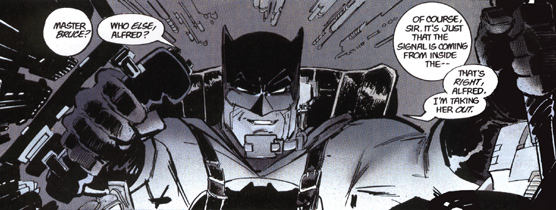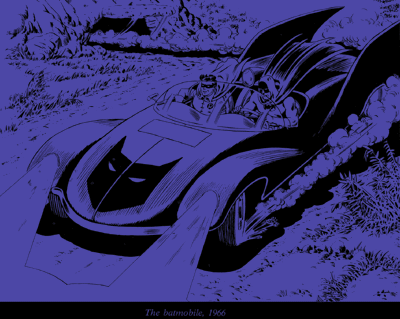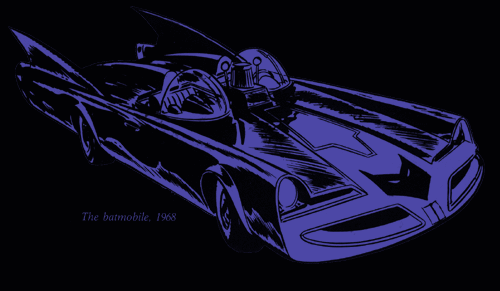
THE BATMOBILE
"A black thunderbolt on wheels, a swift nemesis to lawbreakers, a mighty machine of justice... that's the batmobile!"
The term "batmobile" designates the specially designed and equipped automobile employed by Batman and Robin. In the early days of Batman's career, however, there was no special batmobile. Throughout 1939 Batman drives a series of red sedans which vary slightly in design from text to text, including a special built high-powered auto.
By January 1940 Batman has begun driving a dark blue roadster which he continues to drive through the Fall of 1940. In one text, however, it is portrayed as red. According to Batman #3, "the tires of the Batman's car are coated with a radio-active substance which glows under an infra-red ray," thus making it possible for either Batman or Robin to follow the invisible tracks left by the vehicle.
In February 1941 Batman's roadster, here colored red, appears with a small batlike ornament adorning the hood, and for the first time in the chronicles the term "batmobile" is used. Detective Comics No.48 notes that it "flashes through the street with bullet speed, to the quiet purr of a supercharged motor.
In March 1941 the batmobile is a red roadster for the very last time in the chronicles. It lacks the distinctive batlike hood ornament of the previous month and, in structure and design, more closely resembles the roadster driven by Batman throughout 1940.
Spring 1941 brings with it an array of fundamental changes in batmobile styling that are destined to endure for very nearly a decade. The new vehicle is a dark blue "super-charged car" with a hard, fully enclosed top; a distinctive bat-head front; and a single sharklike tail fin protruding backward from the rear portion of the roof.
It is a car of weird design and blinding speed, the fleetest car in the world, a sleek, rakish vehicle that flashes through the streets like a runaway meteor of streamlined steel.
Fashioned out of special reinforced glass and steel to enable it to smash through barriers and withstand collisions, it is equipped with special tires; has a secret throttle for high-speed travel to prevent criminals from commandeering it for high-speed get-aways; and, buoyed up by air tanks and propelled by retractible props, can even travel through the water.
By April-May 1946 Batman and Robin have installed new rocket and jet-propulsion gadgets in the batmobile to give it enough extra power to overtake a comet, and in June-July 1949 they equip the batmobile with closed-circuit television.
"It will mean faster and better identification of criminals," explains Batman. "Now, police can flash us pictures of wanted crooks, rather than just descriptions."
By July-August 1949 Batman and Robin have installed a new handset in the batmobile to enable them to receive direct telephone communications from Police Commissioner Gordon.
Other batmobile equipment and accessories include a built-in makeup kit that flips into view at the touch of a secret button; a special direction finder for picking up the continuous emergency signal broadcast by the tiny, low power short wave transmitter in Batman's utility belt; a spare Batman costume; and an inhalator, gas masks and other equipment.
In February 1942, and intermittently for two years thereafter, the batmobile is portrayed with red streaks on either side of the body, but these streaks make their last appearance in February-March 1944. From Spring 1941 onward the batmobile is always dark blue, but at least one text describes the vehicle as black and it is indeed possible to interpret the batmobile's coloring as black with dark blue highlights.
By August-September 1942 Batman has installed at least one spare batmobile in his subterranean batmobile garage.
The batmobile remains substantially unchanged for nearly a decade, the most distinctive change being in the evolution of the tail fin, which gradually grows larger, beginning on the top of the car at the center of the roof and extending backward to end in a distinctive, deeply scalloped edge.
In February 1950, however, after the batmobile has careened off a dynamited bridge during a high-speed auto chase and been completely demolished, Batman and Robin design and construct a new one. The new vehicle, dark blue and fully enclosed like its predecessor and retaining the distinctive bat-head front, features dramatically modern, streamlined styling; an enlarged, gently angular tail fin; a transparent plastic bubble top instead of a windshield; and a powerful roof-mounted searchlight.
The new batmobile has blinding speed; can accelerate to 100 miles per hour in 100 feet, and stop on a dime; and is ten years ahead of anything else on wheels.
Its permanent fixtures include: closed-circuit television, including built-in monitor and portable camera; a built-in radar screen, serviced by radar antennae in the tail fin; a built-in crime-lab complete with built-in cabinets, workbench, stool and everything necessary for making tests on the run; and powerful rocket tubes, installed in the fenders, which provide the vehicle with bursts of tremendous speed for short distances, enable it to hurtle over obstacles, and make it possible for Batman and Robin to blanket the surrounding area with chemical blackout fog to blind and confuse their adversaries.
In addition, the distinctive bat-head front-ornament now houses a knife-edge steel nose for cutting through barriers and the roof-mounted searchlight has been equipped to throw either a bat-symbol or a powerful light beam.
Equipped with a special shock-bumper to enable it to withstand the impact of high-speed, front-end collisions, the new batmobile's shockproof and waterproof, features crash-proof construction, and is tougher than an ordinary armored car.
Powerful emergency searchlights have been installed in the headlights. The turning radius of the vehicle is 40 feet.
Other special equipment installed in the new batmobile includes a sonic range finder; an emergency-cable and power-hoist for extricating the vehicle from ditches and quicksand; a fire extinguisher mounted on the outside wall, just behind the driver's seat; a short-wave police radio; a Geiger counter which the Dynamic Duo install in June 1951; and a concealed tape recorder which plays misleading ambient sounds to blindfolded visitors being brought to the batcave in order to prevent their retracing the route later by utilizing sound-clues.
Stored in the batmobile, along with its traveling research files and black cloth toolbag, are several spare Batman costumes, asbestos suits for fighting fires, and special grappling equipment for latching onto fleeing getaway cars and forcing them to a halt.
By July 1958 a pair of whirly-bats have been installed in the batmobile's trunk, and by December 1960 an inflatable rubber bat-raft has been stored there also.
In special emergencies, the batmobile can be outfitted with snowmobile equipment to enable it to travel over snow; with a special duck chassis to enable it to move both on land and in water; or with heavy steel plates that transform it into an armored batmobile, powerful enough to withstand a hurricane. Beginning in April 1955, the batmobile can also be operated by radio remote-control.
At least one spare batmobile is housed in the batcave. The flying batcave houses a smaller version of the batmobile called the "bat-racer."
The batmobile introduced in early 1950 remains substantially unchanged for fourteen years, the major changes being the deepening scalloping and increasing stylization of the tail fin, the squaring of the fronts of the fenders, and the replacement of the doors by a plastic-bubble top that tilts back on a hinge to permit the passengers entry and exit.
In June 1964, however,realizing that the trend now is toward sports cars—small, maneuverable jobs, Batman introduces an entirely different batmobile, a dark blue sports-car convertible with twin tail fins and a stylized black bat-head emblem painted on the hood.
Smaller, sportier, and less cumbersome than its predecessor, the new batmobile features a portable crime-lab complete with microscope and other equipment; a hot-line telephone to the office of Police Commissioner Gordon; a special sound effects gimmick that simulates the noise of a motor receding into the distance; a dashboard button for opening and closing the camouflaged entrance to the batcave by remote electronic control; a special-filter windshield for following the invisible infrared trail left by the chemically treated tires of Alfred's motorcycle; and a special emergency signal that sounds whenever Batman is needed by the Justice League of America, an organization of heroes of which he is a member.
In April 1965 Batman and Robin equip the batmobile with the newly invented encephitector, a device that picks out and filters the alpha waves that a human brain gives out, reacting whenever it receives wave-patterns that show a person is thinking about committing a crime and thereby facilitating Batman's task of locating and apprehending criminals.
By July 1965 Batman has equipped the batmobile with an alarm that sets off a screaming siren and locks the ignition as a precaution against any attempted theft of the vehicle.
By May 1966 Batman and Robin have equipped the batmobile with a new hydrofoil attachment and rear-end propeller that enable the vehicle to travel over land or water on a cushion of compressed air.
The sports-car batmobile remains substantially unchanged for approximately two and a half years, the major changes being the gradual increasing of the overall size of the vehicle, the enlarging of the tail fins in proportion to the size of the body, the substitution of bucket seats for the single front seat, the introduction of anew design for the bat-head emblem on the hood, and the addition of such accessories as a roof-mounted searchlight just behind the front seats.

By December 1966 the stylized black bat-head emblem painted on the batmobile's hood has been replaced by a metal bat-head affixed to the front of the vehicle, and, in the year and a half that follows, the batmobile undergoes a series of minor design variations culminating in this 1968 dual-cockpit model:

|

|
Special equipment introduced during this period includes the bat-tector: an ingenious sound-detecting device capable of distinguishing different types of sounds from gunshots to bomb explosions and pinpointing their sources, and a sophisticated amplifier sensitive to human heartbeats.
"Ah!" thinks Batman to himself as he drives through the city. "My improved sound amplifier is picking up the thump of human heartbeats--in that dark building! Heartbeats that I've graphed as telltale signs of criminal activity!"
In December 1969, when Batman closes up the batcave and departs Wayne Manor for a new penthouse home in the heart of Gotham City, the batmobile is one of the pieces of equipemt that remains left behind. In it's place, Batman substitutes a sleek turbo-powered sports car, equipped with on-way mirrored windows and windshield to enable him to see out while preventing passersby from seeing in; bulletproof chassis and window glass; front-end hydraulic impact absorbers; a device for creating smoke screens; and remote-control machinery operated by means of a tiny micro-control on Batman's utility belt.

entry origin: btta α 0.01